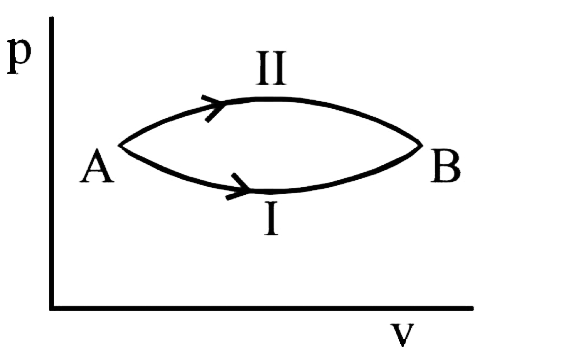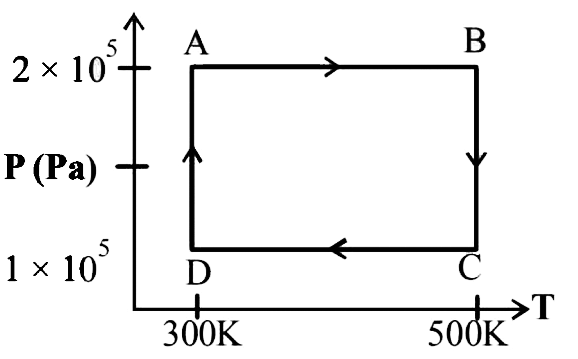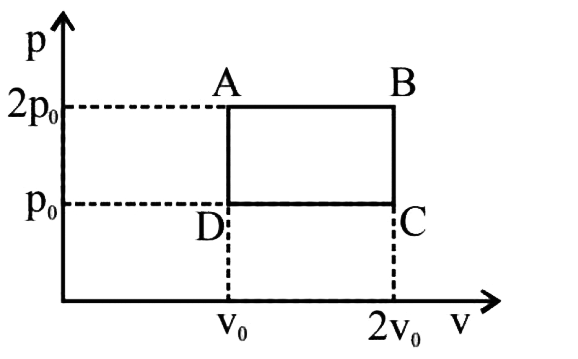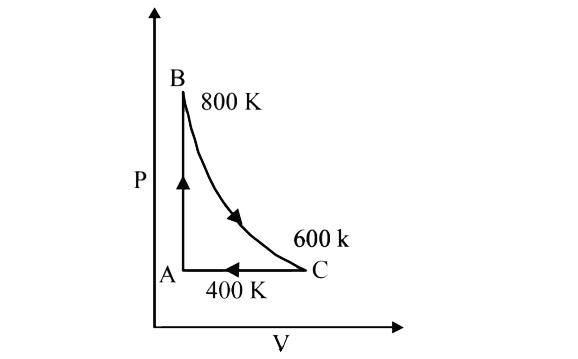Complete Solutions to PART - II of chapter KTG & THERMODYNAMICS of Class 11 book with complete answers and questions
| Class 11 | PHYSICS |
| Chapter | KTG & THERMODYNAMICS |
| RESONANCE | PART - II |
| Number Of Questions | 27 |
| Academic Year | 2023-24 |
Which of the following is incorrect regarding the first law of thermodynamics?
View SolutionA gaseous mixture consists of 16g of helium and 16 g of oxygen. The ratio `(C_p)/(C_v)` of the mixture is
View SolutionA system goes from A and B via two processes. I and II as shown in figure. If `DeltaU_1 and DeltaU_2` are the changes in internal energies in the processes I and II respectively, then

View SolutionThe temperature-entropy diagram of a reversible engine cycle is given in the figure. Its efficiency is:

View SolutionTwo rigid boxes containing different ideal gases are placed on a table. Box A contains one mole of nitrogen at temperature `T_0`, while Box contains one mole of helium at temperature `(7/3)T_0`. The boxes are then put into thermal contact with each other, and heat flows between them until the gasses reach a common final temperature (ignore the heat capacity of boxes). Then, the final temperature of the gasses, `T_f` in terms of `T_0` is
View SolutionThe work of 146kJ is performed in order to compress one kilo mole of gas adiabatically and in this process the temperature of the gas increases by `7^@C`. The gas is `(R=8.3Jmol^-1K^-1)`
View SolutionA Carnot engine, having an efficiency of `eta=1//10` as heat engine, is used as a refrigerator. If the work done on the system is 10J, the amount of energy absorbed from the reservoir at lower temperature is
View SolutionIf `C_P and C_V` denote the specific heats of nitrogen per unit mass at constant pressure and constant volume respectively, then
View SolutionWhen a system is taken from state i to state f along the path iaf, it is found that `Q=50 cal and W=20 cal`. Along the path ibf `Q=36cal`. W along the path ibf is

View SolutionAn insulated container of gas has two chambers separated by an insulating partition. One of the chambers has volume `V_1` and contains ideal gas at pressure `P_1` and temperature `T_1`.The other chamber has volume `V_2` and contains ideal gas at pressure `P_2` and temperature `T_2`. If the partition is removed without doing any work on the gas, the final equilibrium temperature of the gas in the container will be
View SolutionTwo moles of helium gas are taken over the cycle ABCDA, as shown in the P-T diagram

Assuming the gas to be ideal the work done on the gas in taking it form A to B is :
View SolutionTwo moles of helium gas are taken over the cycle ABCDA, as shown in the P-T diagram

The work done on the gas in taking it from D to A is :
View SolutionTwo moles of helium gas are taken over the cycle ABCDA, as shown in the P-T diagram

The net work done on the gas in the cycle ABCDA is :
View SolutionOne kg of a diatomic gas is at pressure of `8xx10^4N//m^2`. The density of the gas is `4kg//m^3`. What is the energy of the gas due to its thermal motion?
View SolutionA diatomic ideal gas is used in a Carnot engine as the working substance. If during the adiabatic expansion part of the cycle the volume of the gas increase from V to 32V, the efficiency of the engine is
View Solution100g of water is heated from `30^@C to 50^@C`. Ignoring the slight expansion of the water, the change in its internal energy is (specific heat of water is `4184J//kg//K`):
View SolutionA Carnot engine operating between temperature `T_1 and T_2` has efficiency 1/6. When `T_2` is lowered by 62K its efficiency increase to 1/3. Then `T_1 and T_2` are, respectively:
View SolutionThree perfect gases at absolute temperature `T_(1), T_(2)` and `T_(3)` are mixed. The masses f molecules are `m_(1), m_(2)` and `m_(3)` and the number of molecules are `n_(1), n_(2)` and `n_(3)` respectively. Assuming no loss of energy, the final temperature of the mixture is
View SolutionA thermally insulated vessel contains an ideal gas of molecular mass M and ratio of specific heats `gamma`. It is moving with speed v and it's suddenly brought to rest. Assuming no heat is lost to the surroundings, Its temperature increases by:
View SolutionA container with insulating walls is divided into two equal parts by a partition fitted with a valve. One part is filled with an ideal gas at a pressure P and temperature T, whereas the other part is completely evacuated . If the valve is suddenly opened, the pressure and temperature of the gas will be
View SolutionHelium gas goes through a cycle ABCDA (consisting of two isochoric and isobaric lines) as shown in figure Efficiency of this cycle is nearly: (Assume the gas to be close to ideal gas)

View Solution
The above p-v diagram represents the thermodynamic cycle of an engine, operating with an ideal monoatomic gas. The amount of heat, extracted from the source in a single cycle is
View SolutionOne mole of a diatomic ideal gas undergoes a cyclic process ABC as shown in figure. The process BC is adiabatic. The temperature at A,B and C are 400K, 800K and 600K respectively. Choose the correct statement:

View SolutionAn open glass tube is immersed in mercury in such a way that a length of 8 cm extends above the mercury level. The open end of the tube is then closed and sealed and the tube is raised vertically up by additional 46 cm. What will be length of the air column above mercury in the tube now? (atmospheric pressure =76 cm of Hg)
View SolutionConsider a spherical shell of radius R at temperature T. The black body radiation inside it can be considered as an ideal gas of photons with internal energy per unit volume `u=U/V propT^4` and pressure `P=1/3(U/V)`. If the shell now undergoes an adiabatic expansion the relation between T and R is :
View SolutionA solid body of constant heat capacity `1J//^@C` is being heated by keeping it contact with reservoirs in two ways:
(i) Sequentially keeping in contact with 2 reservoirs such that each reservoir supplies same amount of heat.
(ii) Sequentially keeping in contact with 8 reservoir such that each reservoir supplies same amount of heat.
In both the cases body is brought from initial temperature `100^C` to final temperature `200^@C`. Entropy change of the body in the tow cases respectively is :
View SolutionConsider an ideal gas confined in an isolated closed chamber. As the gas undergoes an adiabatic expansion the average time of collision between molecules increases as `V^(q)`, where V is the volume of the gas. The value of q is :
`(gamma = C_(p)/C_(v))`
View Solution
PART - II questions and complete solutions for chapter KTG & THERMODYNAMICS of RESONANCE ENGLISH of Class 11
All Exercises from RESONANCE Class 11 PHYSICS KTG & THERMODYNAMICS
- Advancel Level Problems
- Board Level Exercise
- Examples
- Exercise -1
- Exercise-2
- Exercise-3
- PART - I
- PART - II
- PART -I
- PART -II
- PART -III
- PART -IV
- Problem
- SECTION
- SECTION (A)
- SECTION (B)
- SECTION (C)
- SECTION (D)
- SECTION (E)
- SECTION (F)
- SECTION (G)
- SECTION (H)
- SECTION (I)
- SECTION (J)
- Solved Examples
- Solved problem
- SUBJECTIVE QUESTIONS